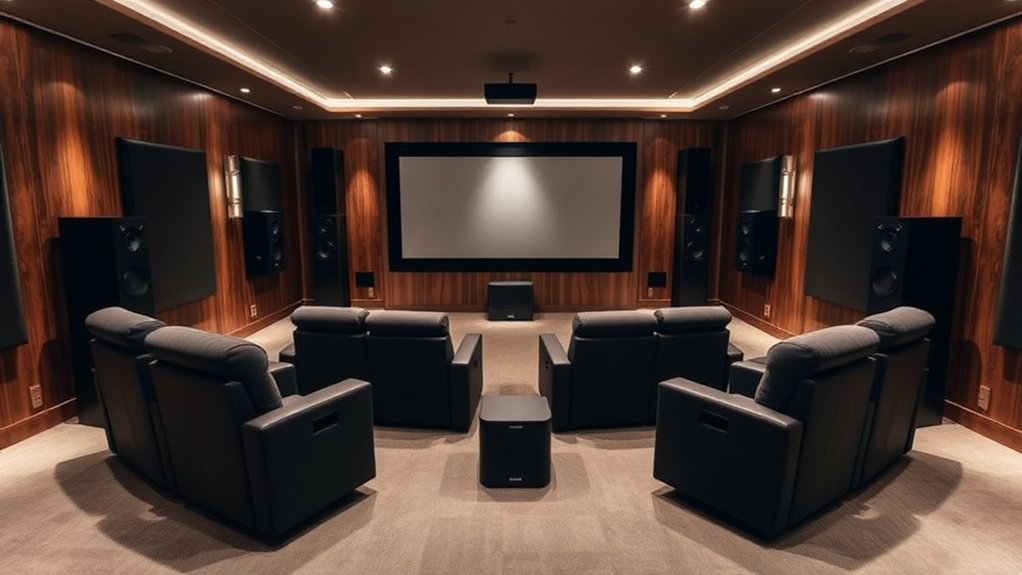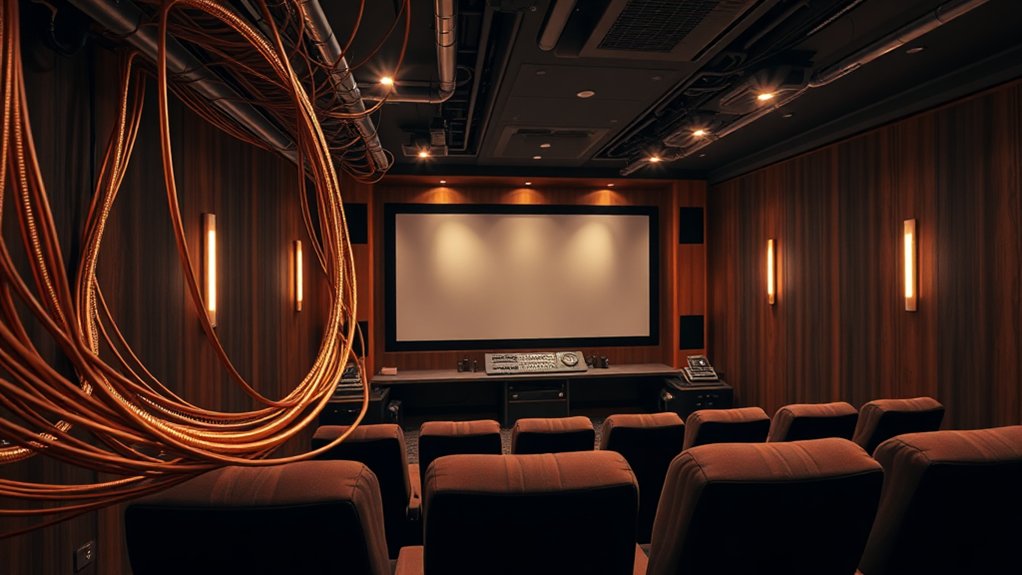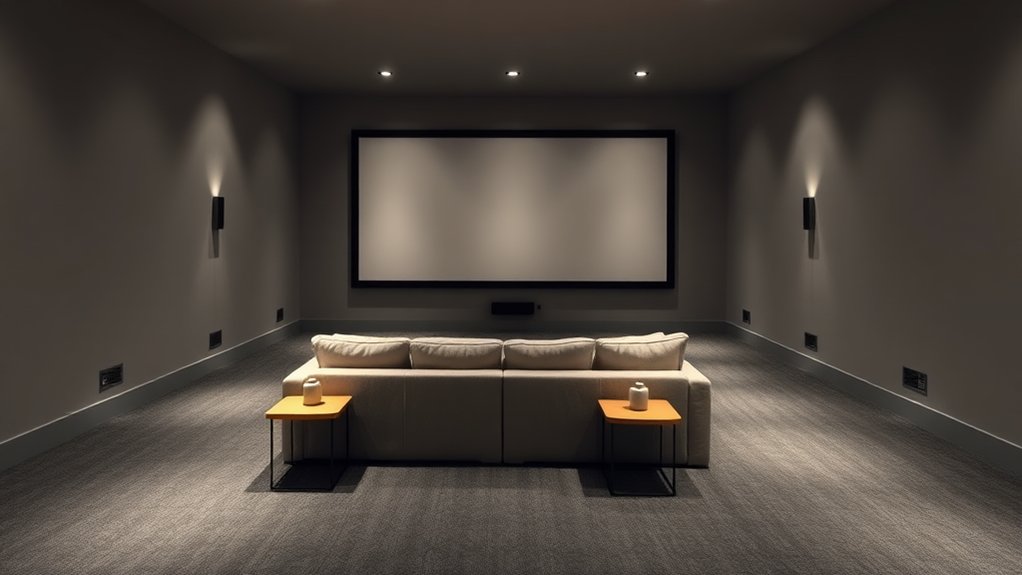To improve theater ambiance, use color strategically; warm hues like reds and oranges evoke joy, whereas cooler tones create tension. Layering lights adds depth; mixing key, fill, and accent lights gives your scenes life. Think of dim lighting for suspenseful moments, as it builds mystery (who doesn’t love a good scare?). And don’t forget those upbeat celebrations—high-intensity lights can energize! Curious about how to balance changes and shadows? Stick around; there’s more to investigate.
Key Highlights
- Utilize warm hues to create inviting atmospheres and enhance emotional connections with the audience.
- Layer ambient, task, and accent lights to add depth and dimension, transforming scenes into dynamic experiences.
- Implement low-intensity lighting and eerie shadows to build suspense and create a foreboding atmosphere.
- Use high-intensity, cheerful colors during celebratory moments to evoke joy and energize the performance.
- Regularly test and adjust light positions to maintain optimal angles and avoid unflattering shadows on performers.
Utilizing Color to Set the Mood
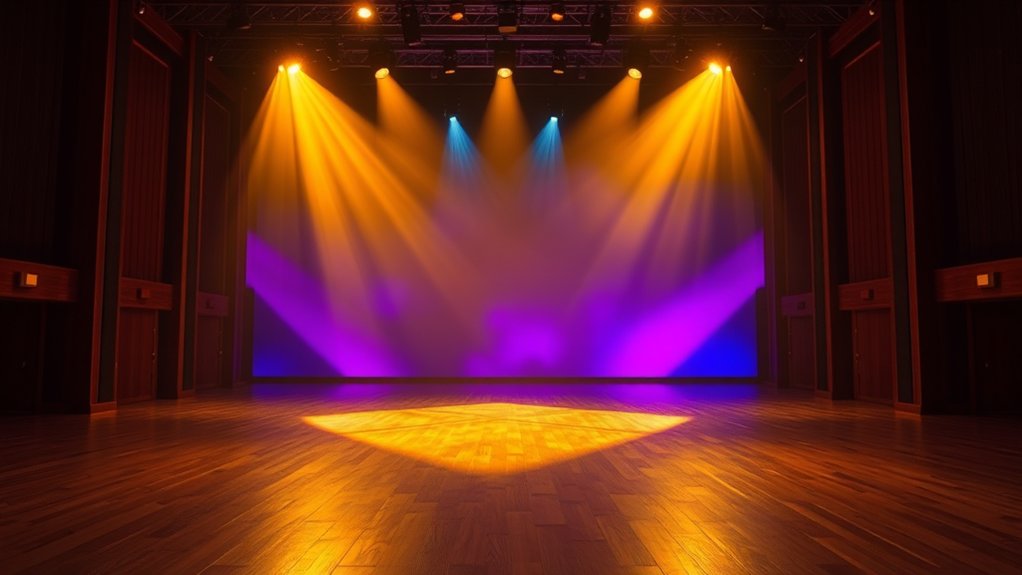
In the domain of setting the mood in theater lighting, understanding the impact of color is undoubtedly essential, and trust me, it’s much more than just a splash of paint on a canvas.
Primary colors like red, green, and blue form the foundation of stage lighting, allowing you to create a vivid palette by mixing them in different intensities.
Ever wondered why red can evoke passion whereas blue might bring on a wave of calm? That’s the magic of color psychology! Moreover, incorporating effective lighting is crucial as it elevates mood and ensures the overall safety within the theater space. Warm hues can create inviting atmospheres, whereas contrasting colors like yellow and blue can intensify emotional shifts. Additionally, understanding the use of various lighting sources is critical for enhancing the overall performance experience.
Layering Lights for Depth and Dimension
By layering lights on stage, you can transform a flat scene into a dynamic visual experience that pulls the audience in. Using a mix of ambient, task, and accent lights, you create a multi-dimensional look, reminiscent of natural environments. Think of your stage as a painting: the key light sets the mood, as fill lights refine shadows, keeping harsh contrasts at bay. Furthermore, incorporating layered lighting allows for an even more dramatic and expressive setup. A well-executed three-point lighting configuration creates depth and mood, enhancing the overall visual experience. By incorporating backlights, you can outline performers, making them pop against the backdrop—almost like adding a lively frame to a photo. Don’t forget uplighting and downlighting; they add vertical depth, casting intriguing shadows.
Creating a Foreboding Atmosphere
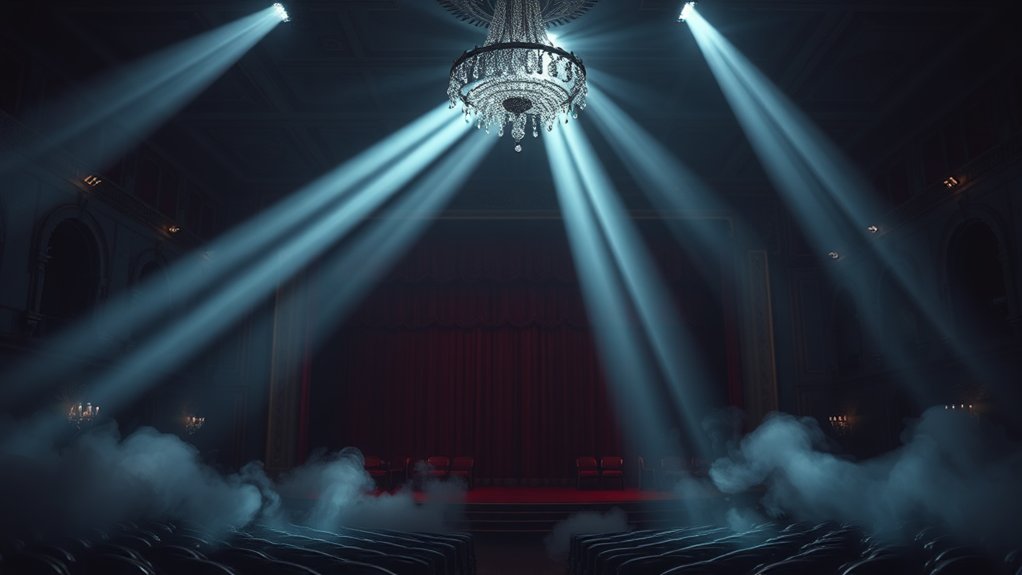
After mastering the art of layering lights for that enthralling, multi-dimensional look, it’s time to explore the darker side of lighting design.
To create a foreboding atmosphere, you’ll want to adopt low-intensity lighting, which reduces visibility and nurtures an unsettling sense of mystery. Think about how dim lighting can create eerie pockets of shadow, suggesting hidden threats ready to pounce. Using cool colors like deep blues can send shivers down your audience’s spine as muted reds hint at impending doom. At the same time, strategic side and backlighting will cast dramatic shadows, enhancing emotional tension. Additionally, understanding the principles of color theory can help you select hues that intensify the haunting ambiance.
Finally, play with selective visibility—spotlighting key characters as leaving the surrounding darkness can amplify curiosity and suspense. Who knew shadows could be so theatrical?
Bright Lighting for Celebratory Moments
How do you transform a theater’s energy from somber to celebratory in an instant? By cranking up the lighting, of course!
Bright, high-intensity lights create an energized atmosphere that makes the audience feel the joy. Using key and fill lights not only illuminates performers but also improves visibility and vibrancy.
Combine that with downlights washing the stage in cheerful hues—it’s like putting the spotlight on celebration itself. With warm colors—think yellows, oranges, and reds—you’re tapping into psychological joy.
And don’t forget backlighting; it separates performers from the background, allowing their movements to dazzle. Layer your lighting techniques, and voila! You’re not just celebrating; you’re giving the audience an experience they can’t forget.
Smooth Transitions Between Lighting States

Even though lighting can dramatically improve the mood of a theater production, the ability to shift smoothly between different lighting states might just be the unsung hero of stagecraft.
Implementing a master/slave system is vital; it guarantees that one “master” light controls multiple “slave” fixtures, keeping everything in sync and avoiding those awkward flashing moments.
A master/slave system is essential for synchronized lighting, eliminating awkward flashes and enhancing the overall visual experience.
By assigning roles to your fixtures—like using uplights for backgrounds—you create a cohesive visual story.
Now, don’t forget about fade-in and fade-out timings. Gradual adjustments keep your audience immersed, unlike jarring snaps that make them wonder what just happened.
Finally, layering different types of lights allows for dynamic control, making certain those changes aren’t just smooth, but engaging.
Plus, who doesn’t love seamless visuals?
Highlighting Key Elements of Your Space
Illuminating the key elements of your theatrical space can truly transform how audiences perceive your production, boosting both the visuals and the storytelling.
By strategically positioning front lights to highlight performers’ faces, you guarantee expressive clarity, as background lighting creates dramatic silhouettes that improve engagement.
Don’t forget downlighting for those intimate solos—it’s like giving a warm hug to the mood.
Side lighting sculpts movement beautifully, especially in choreography, as footlighting fills in troublesome shadows.
So, why not use a mix of lighting fixtures? Fresnels for soft washes, PAR cans for lively hues, and spotlights for those standout moments can create an enchanting atmosphere.
In the end, the right lighting draws attention where it matters, guiding your audience’s emotional expedition.
Balancing Light and Shadow for Visual Interest
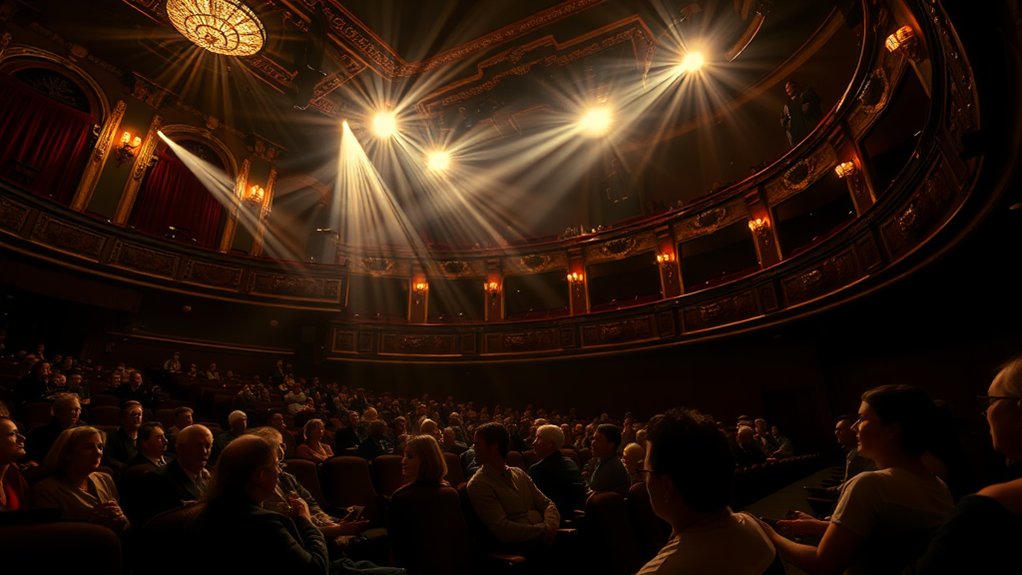
When you think about theater lighting, it might be easy to overlook the subtle yet powerful interplay between light and shadow, especially since mastering this balance can improve your production to a whole new level.
By using contrasting colored lights, like red and green or orange and medium blue, you can create dynamic visual contrasts that elevate your stage presence.
Positioning your lamps strategically, say with high front lights and lower backlights, offers depth as it softens harsh shadows.
Remember, adjusting brightness is essential; too much can wash out emotion, as gentle shadows can evoke intimacy.
Innovative Lighting Techniques for Home Theaters
Creating an inviting atmosphere in your home theater isn’t just about picking the right movie; it’s also about how you light the space.
Start by installing LED strips behind your screen or along crown moldings. These not only improve ambiance with indirect light but also offer an energy-efficient option, using up to 90% less power than traditional bulbs!
Dimmable recessed lights are another great choice, allowing you to create brightness zones that suit different activities. Imagine adjusting the lights from full brightness to near darkness with just a touch!
Wall sconces can add character as you provide gentle illumination without causing glare on your screen.
With all these techniques, you’ll transform your space into a cozy cinematic haven. Who could resist that?
Enhancing Audience Engagement Through Lighting
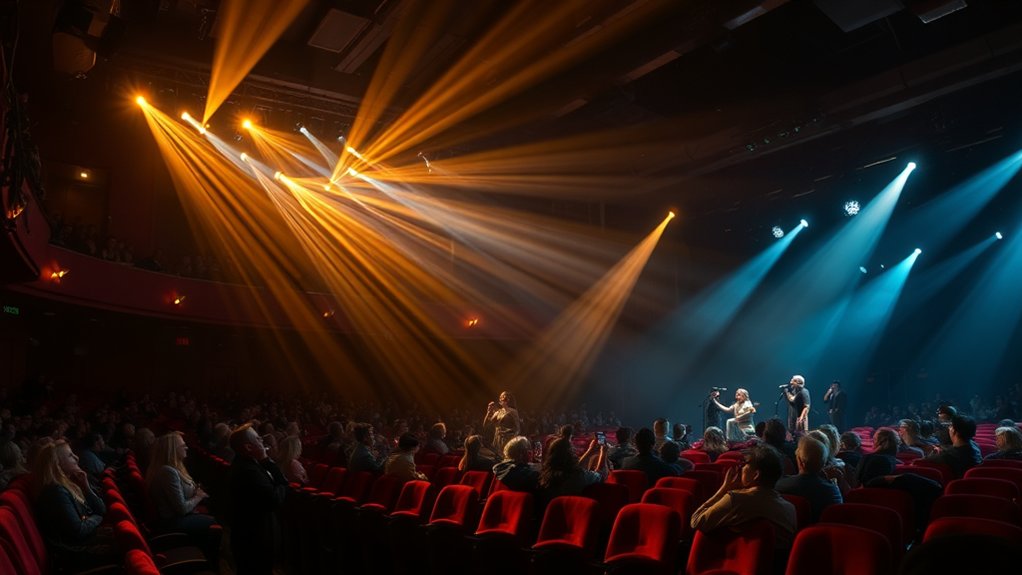
Imagine the buzz in a theater as the lights shift, expertly choreographed to whip the audience into a whirl of emotions right from the start.
Different colors can evoke feelings—warm tones offer comfort as cool tones heighten tension. When you spotlight key moments, it draws the audience in, creating an intimate connection.
Ever notice how a sudden blackout makes your heart race? Those quick changes build suspense! Gradual shifts guide emotional pacing, ensuring you’re fully immersed.
Timing is everything; it’s like synchronized movement—when lights change with plot twists, you can’t help but lean in closer. Layering shadows further enriches storytelling.
Testing and Adjusting for Optimal Viewing Conditions
Though achieving the perfect lighting setup might seem like a challenging task, it’s actually about understanding how different elements interact on stage. Start by testing light positions; for example, front lighting should ideally hit near a 45-degree angle. This angle avoids those annoying shadows that can create unflattering looks.
Next, adjust intensities—too bright washes out details whereas too dim turns your performers into shadows themselves. Feel free to experiment with a mix of ambient and accent lights, ensuring that neither distracts from the performance.
Finally, don’t forget that color temperature matters! Warmer tones create a cozy vibe, whereas cooler ones promote clarity. So, why settle for boring lighting when tweaking can improve your theater’s ambiance? Just remember, balance is key!
Frequently Asked Questions
What Types of Lighting Fixtures Are Best for Small Theaters?
For small theaters, consider using ellipsoidal reflectors for precision, PAR lights for lively washes, and Fresnel lights for soft illumination. Combining these creates versatile lighting that improves the overall atmosphere and audience experience.
How Does Lighting Affect an Actor’s Performance?
Lighting notably influences your performance by setting the emotional tone, enhancing visibility, and supporting focus. It shapes how your expressions are perceived and helps immerse you deeper into your character’s emotional terrain on stage.
What Are the Most Common Lighting Mistakes in Theater?
You’ll often encounter common lighting mistakes in theater, like poor planning, inadequate equipment, and timing errors. These issues can distract the audience, hinder performances, and diminish the overall experience, so careful consideration is essential.
Can Lighting Design Impact the Narrative Structure of a Play?
You can use lighting design to greatly impact a play’s narrative structure. By manipulating intensity, color, and movement, you guide audience focus, improve emotions, and deepen character development, ultimately enriching the storytelling experience.
How Do Lighting Cues Integrate With Sound and Music in Performances?
Lighting cues sync with sound and music, enhancing emotional peaks and creating immersive experiences. You’ll notice how focused lighting highlights moments, matching rhythms and intensities, making the performance more engaging and memorable for the audience.


